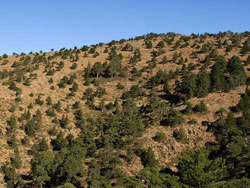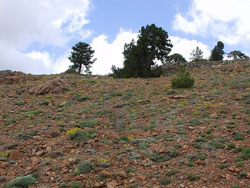|
Environment
A Wonderland with Troodos at its Heart
Dense forests and unexplored vegetation
The major part of the Geopark is covered by forests and dense natural vegetation. It is no accident that the area contains the island’s most noteworthy forests, including the Adelphi and Papoutsa Forests, the Troodos National Forest Park and the largest part of the Paphos Forest. It is state-owned land for the most part but there are significant privately-owned wooded areas which alternate with cultivated farmland and residential areas, thus creating unique sites of exquisite beauty and high ecological value.
Let’s take a closer look at the main types of forest in the area:
(a). Pine Forests
Natural forests with a rich biodiversity, consisting mainly of East Mediterranean pines (Pinus brutia) that form a natural habitat. In the highest parts of Troodos, over 1,100 metres above sea level, we find the black pine (Pinus nigra subsp. pallasiana) which forms natural evergreen forests and which, in turn, are priority habitats (i.e. in danger of disappearing on an EU level).
|
 |
(b). Riparian Forests
These are natural forests adjacent to rivers and streams, in areas with a slight incline and at altitudes of up to 1,600 metres. Since Troodos includes the largest streams in Cyprus, its riparian forests are the most notable ones, containing species such as the oriental plane tree (Platanus orientalis), the oriental alder (Alnus orientalis), the white willow (Salix alba), the bay laurel (Laurus nobilis), the nerium oleander (Nerium oleander), Tamarisk (Tamarix spp.) and more.
(c). Golden Oak Shrubland
The area contains the largest and most representative Golden Oak (Quercus alnifolia) forests, which form priority habitats across an altitude band ranging from 500-700-1,650 metres.
|
 |
(d). Thickets
These are natural plant communities, probably the result of long-term human intervention, and are widely accepted as the plant communities with the highest biodiversity and with typical species such as Cistus spp., Sarcopoterium spinosum, Micromeria spp., etc.
(e). Juniper Woodlands
In the areas of Papoutsa, Madari, Troodos and the Paphos Forest, unique woodlands have been formed at medium and high altitudes (1,000-1,952 metres) containing various species of juniper, creating different habitats: woodlands with Juniperus excelsa and Juniperus foetidissima, clumps of Juniperus foetidissima and woodlands with Juniperus oxycedrus.
|
 |
 |
(f). Cyprus Cedar Forests
In the Tripylos area of the Paphos Forest, the world’s only forest of the endemic cedar (Cedrus brevifolia) is to be found. It has been recognised as a priority habitat and is protected as such.
|
(g). Troodos Serpentinophilous Grasslands
A natural priority habitat, similar to those of Akamas and the Limassol Forest, is formed in open spaces at an altitude of 1,600-1,900 metres, on the Troodos serpentinophilous grasslands. In essence this is a botanist’s paradise, hosting a huge variety of rare, endangered and endemic plants which are found only in this particular habitat and have adapted fully to the particular ecological conditions of the geological substrate.
|
 |
 |
(h) Troodos Peat Grasslands
This natural habitat is extremely rare and in danger of disappearing on a European level. Located in two adjacent areas of the Troodos Natural Forest Park, where depressions are formed and the ground stays moist for most of the year, it contains endangered endemic and other important plant species. At the same time, the peat grasslands are of great scientific value since in them lies the history of the development of every type of vegetation in the Troodos area, a history that remains to a great extent unresearched.
|
(i) Other habitats and types of vegetation
The above-mentioned forests are only the beginning. In the broader region, various other types of vegetation with a rich biodiversity are to be found, including bay laurel (Laurus nobilis) woodlands, Mediterranean dry grasslands with grass, Eastern Mediterranean and annual grasslands, Eastern Mediterranean scree, siliceous rocky slopes with chasmophytic vegetation, cypress woods in the Adelphi Forest and olive and carob groves at lower altitudes.
All these forests and wooded areas, due to their particular importance, receive special treatment and protection with the objective of maintaining their ecological role and the strengthening of the biodiversity that they host. Large parts have been integrated into the Natura 2000 Network while others have been declared National Forest Parks (such as the Troodos National Forest Park) or Nature Reserves, such as Cedar Valley, the Mavri Gremmi and Black Forests at Madari.
|